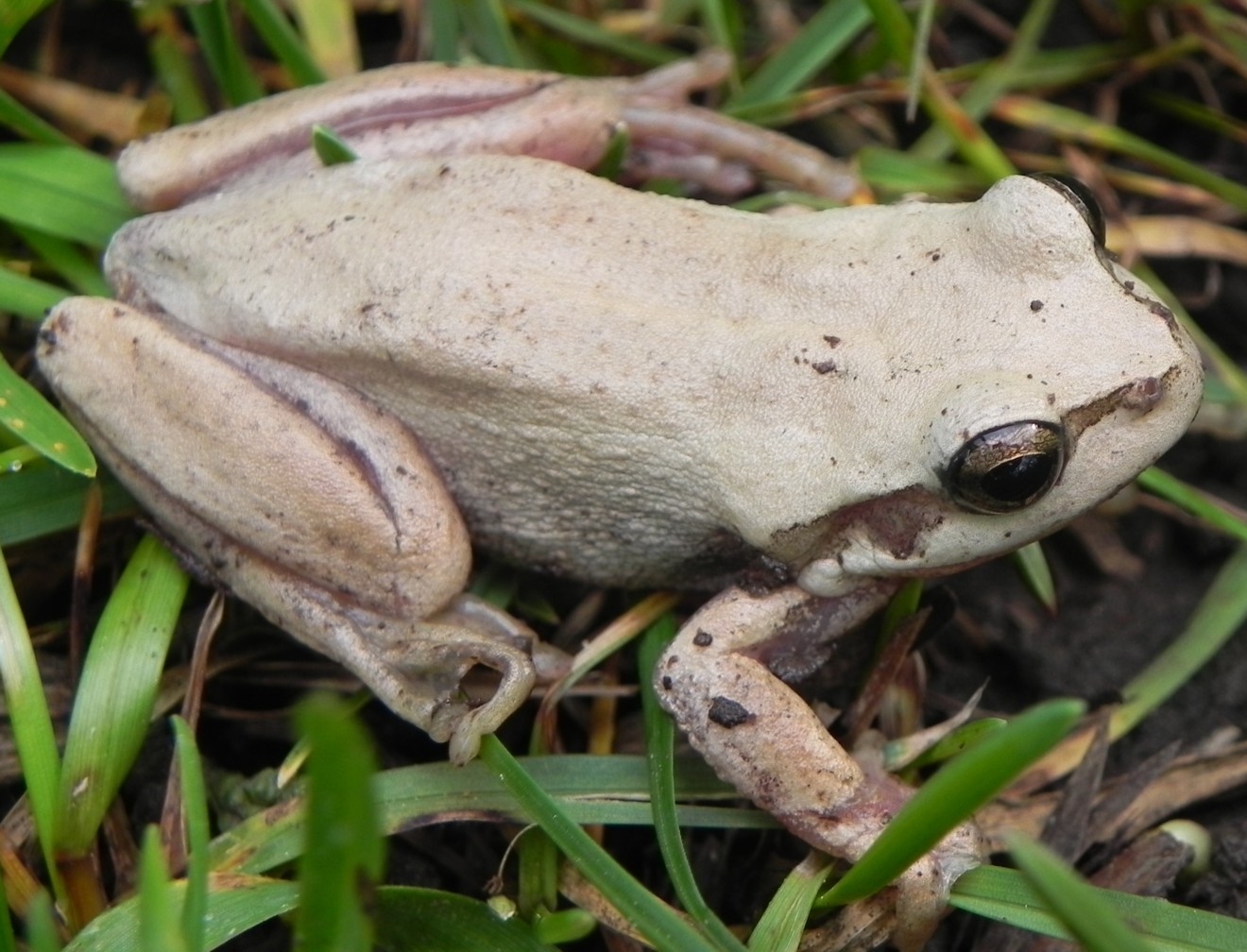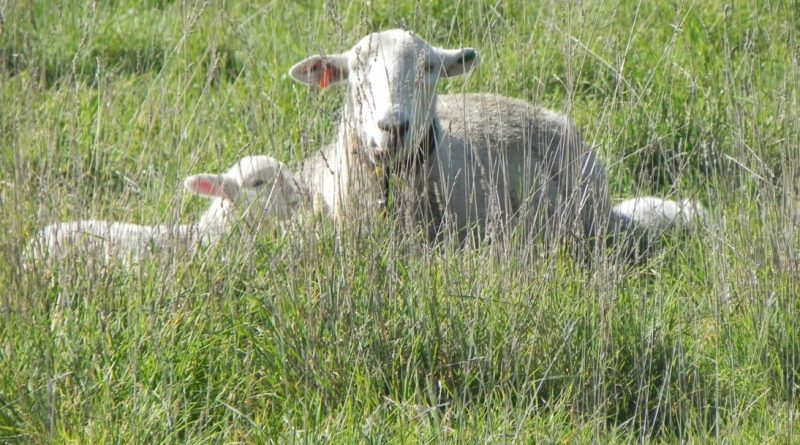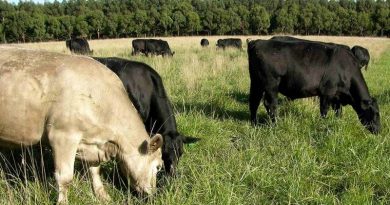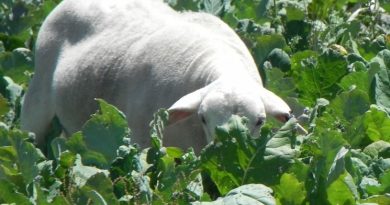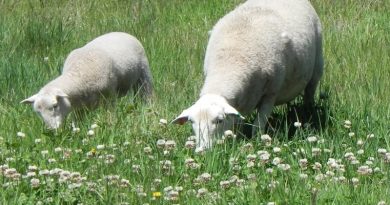Moffitts Farm Spring 2016 Update
It’s hard to imagine that seasonal rainfall conditions can change so dramatically, as happened between May and September. After 30 months (starting November 2013) of receiving about 70% of average monthly rainfall, May 2016 received about 150% of the average, similarly for June, then in July it was about 200% of the average, August fell back to average, and September jumped up again to 200% of the average for the month.
The impact of this rain by the end of July was enormous. Our creek which last flowed in October 2014 was flowing again. Most of the dams were filling because the soil moisture profile was full and run-off commenced. Our pasture cover and length ensured this runoff was clear, no nutrients or soil being washed into the dams or creek.
But the biggest impact events were yet to come. August rainfall and temperatures were average – wet and cold but nothing extraordinary which was great for our lambing which was completed over three weeks to 30 August. On 10 September an extreme rain event happened over five days with 105mm falling. This caused a creek flood the height of which I have only seen once before (in spring 2010 when 302mm fell in two months). Due to our farm’s topography the flood had little impact on infrastructure with only a little tree debris caught in fences and rocks in the main creek crossing washed away. It did however, isolate sheep as they would not cross the creek until the level went down sufficiently to negotiate a way across on the visible rocks. Having “leader” sheep was a great assistance in moving flocks across the creek at this time. The “leader” sheep trust humans and follow you even across flowing creek water (running between rocks) and bring the rest of the flock with them.
At the time of writing this report there has been 175mm in September, which is 233% above the monthly average. This is the highest September rainfall since 1993.
Figure 1: In mid-September our creek reached close to the highest level ever seen. The creek had no water in it just four months earlier.

Lambing
Moffitts Farm Wiltipoll ewes were joined with rams in mid-March. Pregnancy is five months, so lambing would start from 8 August. Prior to and during the five week joining period the ewes’ pasture nutrition was managed to ensure they were in condition score 3 (condition score 1 is skinny and score 5 is over fat). Our summer-active pastures helped in this regard because despite a dry summer there were a few small thunderstorms which produced enough rainfall for these perennial grasses to grow green feed.
Lambing actually started on 7 August and was finished except for one ewe on 30 August. Overall lambing progressed as expected in weather conditions that can challenge lamb survival. However, we did not lose any lambs from exposure. This is mainly due to ewes being in condition score 3 or better at lambing and lambing paddock pastures have around 3000kg of herbage dry matter. As explained in an article in the sheep section, wind chill exposure is the cause of the majority of lamb deaths. Our 20 – 30 cm high lambing pastures provide lambs with ground level micro shelter where the wind speed is reduced to near zero. This amount of pasture also provides ewe with plenty of feed in the immediate vicinity of the birthing area, so she doesn’t walk away from her lambs searching for fresh feed.
Figure 2: Lambing paddocks are rested from grazing for approximately 12 weeks prior to pregnant ewes moving in. The resulting 20 – 25cm high pasture with around 3000kg green dry herbage per hectare ensures pregnant ewes have the condition score and nutrition necessary for lambing; and when lambs are born the micro-shelter provided by the tall pasture protects them from wind chill (note the pasture ruler is two 14 cm rulers taped together).
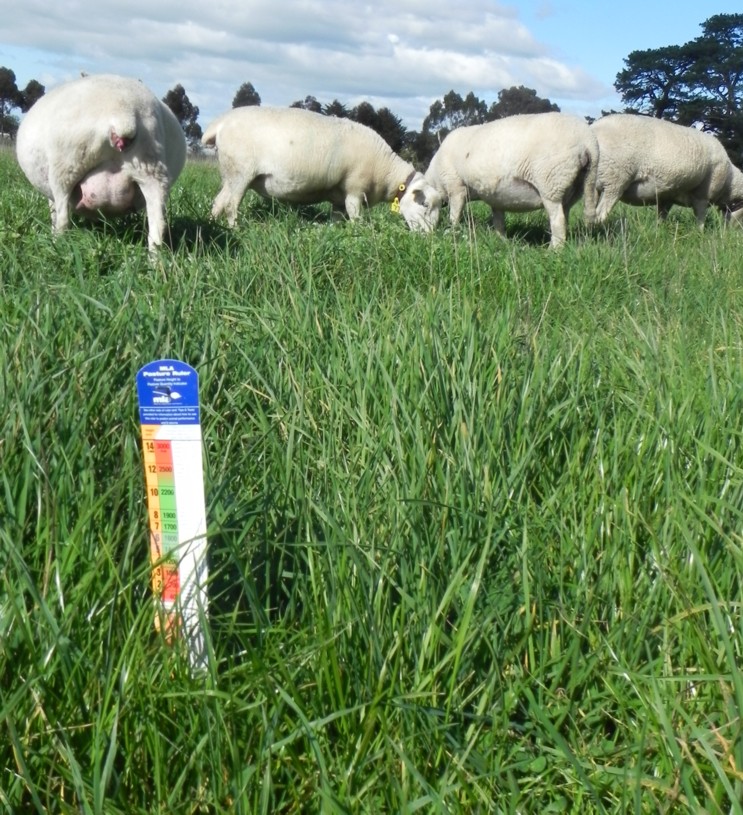
Abandoned lambs combined with mismothering is the second major cause of deaths. We avoid this by having the high levels of pasture feed in the paddock and by using easily read management tags on all ewes’ collars. By shepherding ewes each day we record every birth, check the new born lamb’s health and weight, and give the ewe a maternal behaviour score. So we know if a ewe has a single, twins or triplets, or if one of her lambs has died. This means that if a mix up of lambs did happen in the paddock we can sort out which lambs belong to which ewes. The only delivery deaths experienced this year were lambs which suffocated in the birth membranes. This is rare and usually happens with one of a set of twins or triplets which are born quickly and the ewe fails to clear one lamb’s airways of mucus or membranes.
Figure 3: Easily readable management tags on each ewe’s collar means an accurate record of each birth is easily kept. This ewe also has electronic tag attached to its collar. At lamb marking lambs are given a temporary tag on a collar and a permanent ear tag (compulsory for national disease control programs so all animals can be tracked to the farm they were bred on). The temporary collar enables us to match each ewe to its lamb(s) ear tag. This gives us accurate identification for pedigree and performance recording over each animal’s entire life.
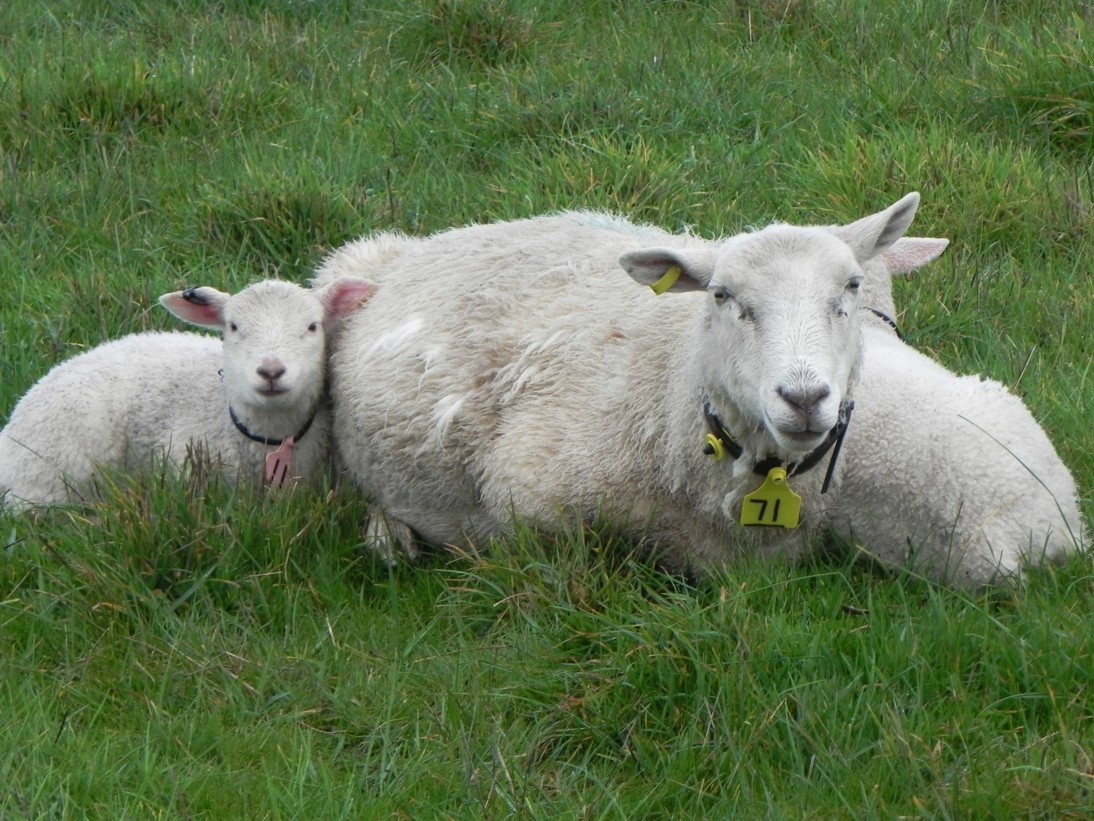
Another shepherding strategy which helps ensure lamb survival is the practice of drift lambing. All lambs born during the night and up to about 2.00PM the next day are drifted into a fresh paddock only containing ewes with lambs.
With these shepherding techniques we keep track of every lamb and ewe. If an intervention is needed we are present to assist. Three ewes needed delivery assistance and were successfully carried out.
We do not move ewes into our shed to lamb, except for the three delivery assistances and there were two ewes with twins which had low birth weights – less than 4kg. Below this weight if extreme weather conditions prevail (temperature below 10C, wind above 10km/hour, and rain or mist), then exposure has potential to kill such a light weight animal. In each of these instances, the shedding is only overnight and the ewe and her lamb(s) are returned to a high herbage mass pasture paddock. These small lambs only need about 48 hours to gain extra strength to be able to withstand severe weather conditions in the paddock (providing micro shelter is present) and the ewe has plenty to eat.
Overall the lamb birth weights were excellent this year with singles mostly between 5 and 6kgs and twins between 4 and 5kgs. Birth weight is a key factor in ensuring lamb survival in severe weather conditions.
Another important aspect of shepherding ewes and lambing is building trust between the animals and humans. On Moffitts Farm we have spent time developing a high level of trust so ewes are not stressed by humans wandering amongst them. This behaviour is built by how the flock is managed, principally grazing management. The flock has learnt to follow humans when called into a fresh paddock every week. In other words, humans are associated with something they like – fresh pasture. Lambs learn from their mothers and by the time they are weaned are also likely to follow. The lambs are assisted in this regard by our “leader” wethers. These are animals which have formed a much stronger bond with humans. They were not raised as pets but like to associate with humans when you enter the paddock. This bond develops as they become older, so they are retained or sold to other farmers who want lawn mowers or leaders for their own flocks.
The lack of fear in the Moffitts Farm Wiltipoll ewes makes drift lambing a practical proposition. Each ewe with its single or twin lambs is easily walked out of the paddock without upsetting it or the other ewes yet to lamb. In most flocks where ewes fear humans it would be impossible to drift of ewes without major stress to the ewe and its lambs and the remaining pregnant ewes.
Tails left on at lamb marking
When the lambs were marked (castrated, given an identification tag and vaccinated against common diseases) the result was 130% lambing rate (that is, a higher number of lambs than ewes by 30%). We weigh the lambs at marking which is at approximately 21 days old; the males averaged 14 kg and females 12.5kg. This means the lambs are gaining around 250 grams per day since birth.
We have tested leaving tails on some of our Wiltipoll ewe lambs over the last three years. Being sheep that shed their wool the reason for tail docking as happens in other wool sheep breeds no longer should apply. Our sheep with tails have no management issues because they shed the wool on their tails just as on the rest of their body. So this year we decided not to remove tails from the lambs. Tail docking has some justification with wool sheep as the tail is difficult to shear. As well, if internal worm control is not managed wooly tails can become covered in poo – called dags.
There is a move in one line of Merino sheep, called Soft Rolling Skin sheep, to breed lambs with short tails so they don’t have to be docked. This initiative is in its infancy but is showing genetic selection promise. It’s another step in the right direction when it comes to improving sheep welfare.
Another reason why Moffitts Farm lambs can retain tails is due to our direct marketing to the MeatSmith shop in Fitzroy. This outlet knows the quality of the lamb carcases it receives, and the fact the live animals have tails has no impact on eating quality. At Moffitts Farm, leaving tails on is another example of young sheep welfare being enhanced. Apart from the shearing and daggy tails issues, the general sheep industry has a tradition of docking tails, so if animals are presented in sale yards with tails, buyers discriminate against them for being different. Farmers with shedding sheep who sell direct to a retail outlet which recognises the importance of animal welfare, can leave tails on their animals as there will be no discrimination against them.
Figure 4: This year all lambs will keep their tails. Note how the lamb lifts its tail, which keeps it clean. The lamb’s mother also has a clean tail.

Fox control
We are pleased to report that no lambs have been taken by foxes. Foxes are not only killers of young lambs but also have a major impact on biodiversity by eating frogs, skinks, and birds. We have a multi-pronged approach to controlling foxes that includes:
- Exclusion fencing with wire netting around all paddocks used for lambing
- Picking up all afterbirth on the day of lambing
- Baiting with Foxoff
- Shooting
- Small solar lights in paddocks to mimic a spotlight.
- Night patrol with spot light.
It is difficult to know how effective each approach is. Foxes were spotted on occasions around the perimeter fences but only three times in the lambing paddocks. Three fox baits were taken and four foxes were shot. Foxes will remain an ongoing issue for our flock and biodiversity as most of our neighbours are not controlling them on their own farms.
Biodiversity notes
Since our last season report in March we have seen sugar gliders for the first time in one of our sugar gum plantations. This is somewhat surprising as the plantation trees are only 10 years old and there are no old remnant trees in the corridor.
Another interesting first sighting was a light coloured frog which might be a southern brown tree frog. This frog was seen in a pasture paddock about 30m from a conservation corridor during a farm walk by delegates to the National Landcare conference. We often find frogs in the pasture, probably because of the bulky herbage mass we retain gives them protection from predators.
The visitors were also thrilled to spot a koala in one of our riparian manna gums (E.viminalis). We had only just finished telling the visitors we planted many manna gums in the conservation corridors to attract koalas back into farms from the nearby Macedon Ranges.
Figure 5: This light coloured frog was found in bulky pasture, it could be a southern brown tree frog?
